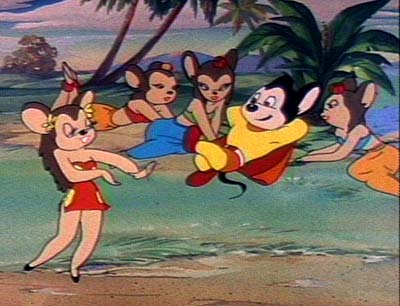This posting is a stub. You can contribute to this entry by providing information through the comments link at the bottom of this post. Please organize your information following the main category headers below….
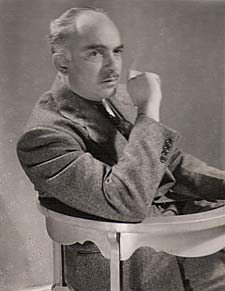
![]() Birth/Death
Birth/Death
Born: February 27, 1906, New York City
Died: September 30, 1993, Thousand Oaks, CA
Occupation/Title
Animator
Bio Summary
Carlo Vinci (originally Vinciguerra), a pioneer of the animation industry for over 50 years, animated hundreds of characters such as Mighty Mouse, Tom & Jerry, Donald Duck, Ruff and Reddy, Quick Draw McGraw, Huckleberry Hound, Yogi Bear, the Jetsons, Scooby Doo and the Flintstones. He became known as the master of the Flinstones. Carlo Vinci could be counted on to deliver quality work at a remarkably fast pace, no matter what he was asked to do. He retired at the rip old age of 72, loved by all in the industry. Carlo passed away on September 30, 1993, leaving behind his wife, Margaret, four children and ten grandchildren.
Early Life/Family
Carlo Vinci was born February 27, 1906, in New York City. A few weeks later in March of 1906, the very first animated cartoon, “Humorous Phases of Funny Faces” was produced. That was destiny in the making! He was the only child of Italian immigrants. His father, Andrea was a barber, and his mother, Maria was a dressmaker, making custom-made dresses before they were available in department stores. In 1938, Carlo met Margaret Leonardi, the love of his life, and the two were married in 1939. They remained married for the next 54 years.
Education/Training
Carlo showed artistic talent at a very early age, and was nurtured throughout his childhood so much so that after he graduated high school, he was awarded a scholarship at the National Academy of Design. He studied day and night for four years and graduated with honors. In 1929, he was awarded a silver medal, the highest award for craftsmanship from the Tiffany Foundation Fellowship.
Career Outline
He spent his first years as an artist in commercial art from 1921 to 1932. He drew murals, landscapes for homes and business offices and also did commercial stained glass. In 1933, during the depression, Carlo heard about the animation industry and wanting a better way to support his family, applied for a job at the Terrytoons Studios. He was paid $75 a week (a lot of money for the time) and in less than a year he became an exceptional animator, specializing in dancing sequences and scenes that required acting and graceful movement.
In 1955, Joe Barbera, a fellow animator at Terry, (now in California and the head of the MGM animation studio along with Bill Hanna) offered Carlo a job. He packed up his wife, four children and dog and drove out to Culver City, California to animate Tom and Jerry and Droopy cartoons. Soon after, there was a bump in the road when MGM decided to close down their animation studio. Joe Barbera helped Carlo get a job at Walt Disney Studios. He worked there for two years on TV projects, and also free-lanced as an animator for Paul Fennell, who was doing animated commercials for television. In the meantime, Joe and Bill were preparing to open their own studio.
Then in 1957, Hanna-Barbera opened, and Joe immediately hired Carlo as one of his first three animators. A few years later in 1960, the Flinstones premiered on television and Carlo animated the first Flinstone cartoon single-handedly. This was the first time a cartoon series was on prime-time television, making television history. He worked on many of the Flintstones episodes, animating an entire 24 minute episode by himself every six weeks. Carlo was featured in LIFE magazine (see below) with a full page photo, featuring him acting out his drawing of Fred Flinstone.
Over the years he was recognized as an accomplished artist and received many awards. He also drew for comic books and later in his career illustrated ads for HARPER magazine drawing the Flinstones characters. In his retirement he continued drawing and painting, especially portraits of his children, their spouses, and grandchildren. He never stopped learning and growing as an artist. As a final challenge, toward the end of his life he began to sculpt.
Comments On Style
TERRYTOONS YEARS
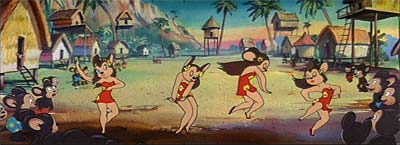
Click to see a larger view.
Carlo moves things as if he invented animation himself and had never seen anyone else’s animation. He made up all his own rules. He doesn’t use simple lines of action like the Disney animators did. Instead he uses zigzagged poses that to most animators would seem awkward. I used to notice that about his Flintstone poses when I was a kid and I loved it. I learned early that the kind of stuff I liked most didn’t fit a mold. It had to be skilled, but also needed to stand out and be a little “off”- like Carlo Vinci.
Here is some of Carlo’s “full-animation” from a 40s Terrytoon. He was using his broken-wrist/collapsing joints theories way back when. The Terrytoons directors always gave him the dance scenes and you can spot his style a mile away.
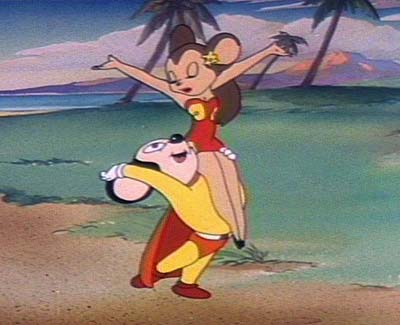
Click on the image above to see Mighty Mouse In Krakatoa (1945 / Quicktime / 13.5 mb).
HANNA-BARBERA YEARS
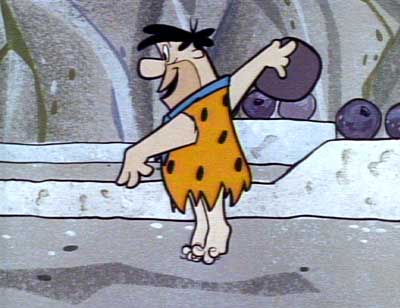
Click on the image to see a movie of Carlo Vinci scenes.
Carlo Vinci is the master of Flintstone. He handles him clean, smooth, without shame. Here’s how to spot him… Carlo loves drawing crooked poses with the characters’ appendages- the head, the hands, the pelvic girdle- all pointing different directions. Keep your eyes peeled for socially unacceptable (in some circles) wrist actions. He likes to flip the wrist around- have the hand up, then flip down, then twist around, fingers wiggling, taking turns sticking up- it’s truly a joy to watch.
He utilizes the butt generously. Remember the old Yogi Bear cartoons? The ones where Yogi bops up and down to bongo beats? That’s Carlo. He’s always thinking of you. In Carlo’s hands, Fred’s butt is a sensative emoting creature. He also draws quite a few meaty expressions on the characters, whereas some other animators are stingy with their expressions. Carlo did great stuff for Terrytoons, but I think he was made for Hanna Barbera. His animation style combined with Ed Benedict’s designs created a whole new entertainment experience. Count on Carlo to deliver a quality package to you. -John Kricfalusi
Influences
Renaissance artists: Michelangelo, Raphael, Leonardo Da Vinci.
Personality
Carlo was known for his great sense of humor, was always the life of the party wherever he went, a great dancer and loved opera.
Anecdotes
Joe Barbera on his first job as an animator…
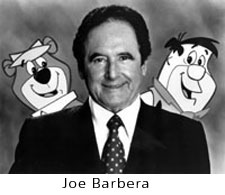
![]() I worked in a bank, and at night I would go home and draw cartoons. It seemed to titillate me when I would see a magazine like a Colliers or a Life or a Judge. So I began drawing cartoons and suddenly they began to buy them. It was very bad times, and finally the bank closed its doors… So, I’m strolling down the street and I meet a fraternity brother, and he says, “Go across the street to 729 7th Avenue and tell them you’re an animator.” I didn’t even know what that meant. So I went in and I had four magazines with me which had my printed material in it. It made enough of an impression on them to decide to hire me.
I worked in a bank, and at night I would go home and draw cartoons. It seemed to titillate me when I would see a magazine like a Colliers or a Life or a Judge. So I began drawing cartoons and suddenly they began to buy them. It was very bad times, and finally the bank closed its doors… So, I’m strolling down the street and I meet a fraternity brother, and he says, “Go across the street to 729 7th Avenue and tell them you’re an animator.” I didn’t even know what that meant. So I went in and I had four magazines with me which had my printed material in it. It made enough of an impression on them to decide to hire me.
They walked me into a room and sat me down at a desk with a light board and gave me a scene which had about thirty pages in it, and I stared at it. I didn’t know what the heck it was all about. But fortunately, a fella next to me- named Carlo Vinci said, “You don’t know what to do, do ya?” I said, “Noooo…” So he said, “Well, I’ll show ya…” He put drawing one down and drawing three and showed me the job of an Inbetweener. He said, “You have to make that drawing inbetween these two drawings.” He described motion to a degree, and that’s how I got started in that end of the business.
Miscellaneous
Filmography
Terrytoons 1933-1955
MGM (Tom & Jerry) 1955-1957
Disney (Donald Duck) 1957
Hanna-Barbera 1957-1982
Honors
Exhibits:
National Academy Gallery, New York City
American Art Gallery, New York City,
Grand Central Gallery, New York City
Tiffany Foundation Fellowship and Silver Medal, 1929
Related Links
Carlo Vinci’s Model Sheets & "The Temperamental Lion" (1940)
Bibliographic References
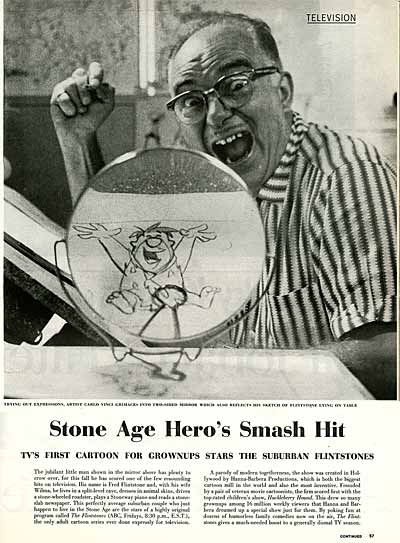
Carlo Vinci in Life Magazine, November 21st, 1960
Contributors To This Listing
Paul & John Vinci, John Kricfalusi, Stephen Worth
To make additions or corrections to this listing, please click on COMMENTS below…















